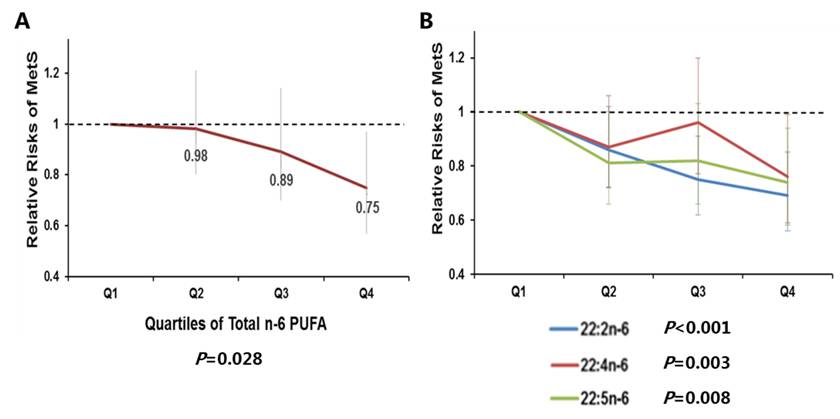Researchers Revealed Associations of Polyunsaturated Fatty Acids, Acylcarnitines with Metabolic Syndrome Risk in Chinese Population
Recently, Journal of Lipid Research online published a work of Professor LIN Xu’s group from Shanghai Institute of Nutrition and Health, Chinese Academy of Sciences entitled “Erythrocyte PUFAs, circulating acylcarnitines, and metabolic syndrome risk: a study in Chinese”.
Metabolic syndrome (MetS), a constellation of cardiometabolic risks, is known as a precursor of type 2 diabetes (T2D) or cardiovascular diseases (CVD). Higher intake of polyunsaturated fatty acids (PUFAs) was showed to be associated with reduced risks of T2D and CVD in Western populations, but little is known in Asians who have different dietary patterns and variations in genes involving PUFA metabolism as indicated by a previous trans-ethnic genome-wide association study (GWAS) of Professor Lin’s group.
Acylcarnitines play an essential role in transporting long-chain FAs across the mitochondrial inner membrane for fatty acid oxidation (FAO). Another study of Professor Lin’s group found that plasma acylcarnitines were significantly associated with 6-yr incident T2D. However, it remains unclear whether FAO status, indicated by specific acylcarnitine profile, could influence the PUFAs-MetS associations.
In the recent published study, Ph.D. candidate MA Yiwei of Professor Lin’s group in collaboration with Associated Professor SUN Qi from Harvard T.H. Chan School of Public Health, investigated the prospective associations of erythrocyte PUFAs with 6-yr incident MetS among 1,245 Chinese aged 50-70 who completed both baseline and a 6-yr follow-up survey from the Nutrition and Health of Aging Population in China (NHAPC). It was found that total n-6 PUFAs and three 22-carbon n-6 PUFAs (22:2n-6, 22:4n-6 and 22:5n-6) were inversely associated with 6-yr incident MetS risk (Figure 1), while 18:3n-3 and 18:3n-6 showed positive associations.

Figure 1: Total n-6 PUFAs (A) and three 22-carbon long-chain n-6 PUFAs (B) with 6-year metabolic syndrome risk.
(Image by Prof LIN Xu's Group)
In addition, a network analysis was used to explore the effects of FA, acylcarnitine and their interactions on the PUFAs-MetS associations. Six modules were constructed and a module mostly consisted of long-chain n-6 PUFAs and very-long-chain saturated FAs was inversely associated with incident MetS. This inverse association became stronger when a module of short- to medium-chain (C5-C10) acylcarnitines were low (Figure 2).

Figure 2: Network analysis of fatty acids and acylcarnitines. (A) Network heatmap; (B) Sub-network of long-chain n-6 PUFA module; (C) Interaction of long-chain n-6 PUFA module (Module 1) and short- to medium-chain acylcarnitine module (Module 6) on metabolic syndrome risk.
(Image by Prof LIN Xu's Group)
Overall, this study showed the favorable effects of total and certain n-6 PUFAs on cardiometabolic outcomes in an Asian population for the first time and also the inter-play between n-6 PUFAs and acylcarnitines might modulate cardiometabolic risk.
This study was funded by the Major Project of the Ministry of Science and Technology of China, the National Natural Science Foundation of China and the Chinese Academy of Sciences.
Media Contact:
WANG Jin (Ms.)
Shanghai Institute of Nutrition and Health,
Chinese Academy of Sciences
Email: sibssc@sibs.ac.cn
